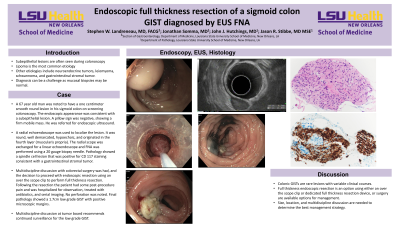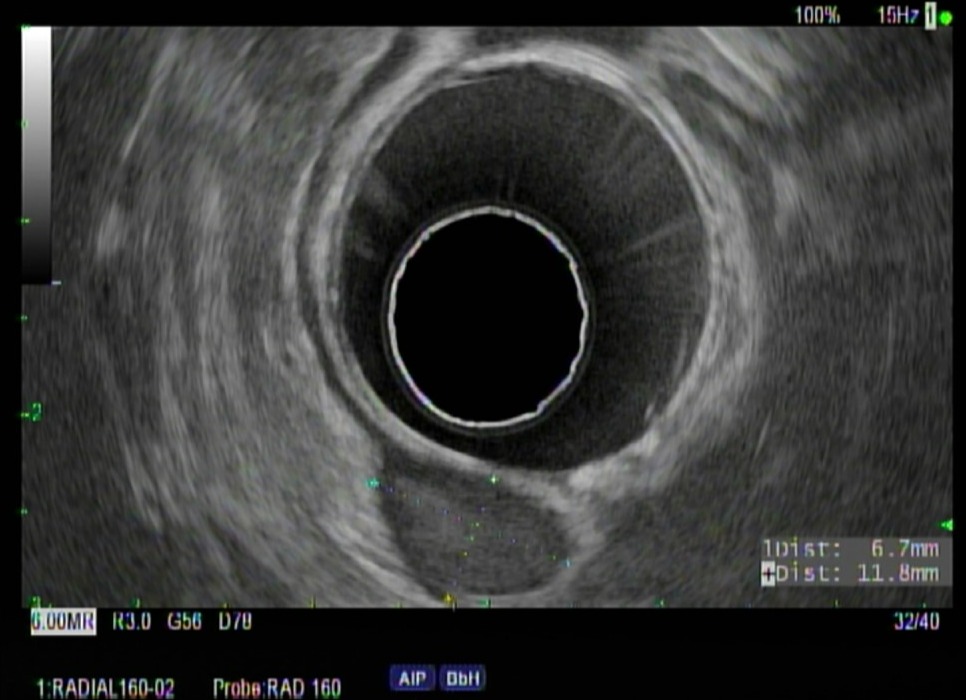Back


Poster Session B - Monday Morning
Category: Interventional Endoscopy
B0472 - Endoscopic Full Thickness Resection of a Sigmoid Colon GIST Diagnosed by EUS FNA
Monday, October 24, 2022
10:00 AM – 12:00 PM ET
Location: Crown Ballroom

Has Audio

Stephen Landreneau, MD
LSUHSC
New Orleans, LA
Presenting Author(s)
Stephen Landreneau, MD1, Jonathan Somma, MD2, John Hutchings, MD2, Jason Stibbe, MD, MS1
1LSUHSC, New Orleans, LA; 2Louisiana State University School of Medicine, New Orleans, LA
Introduction: Subepithelial lesions of colon are often encountered during colonoscopy with lipoma being a common etiology, with other etiologies such as neuroendocrine tumors, leiomyoma, schwannoma, and GIST being rare. While a lipoma can be diagnosed by endoscopic appearance, pillow sign, and fat on biopsy; a diagnostic dilemma is presented if these findings are not present. EUS can be used for lesions that are within reach of an echoendoscope, but the sonographic appearance may still not be diagnostic without tissue sampling. This is a case of a subepithelial lesion in the sigmoid colon noted on colonoscopy that was diagnosed as a gastrointestinal stromal tumor by EUS FNA.
Case Description/Methods: A 67 year old man was noted to have a one centimeter smooth round lesion in his sigmoid colon on screening colonoscopy. The endoscopic appearance was consistent with a subepithelial lesion. A pillow sign was negative, showing a firm mobile mass. He was referred for endoscopic ultrasound.
A radial echoendoscope was used to localize the lesion. It was round, well demarcated, hypoechoic, and originated in the fourth layer (muscularis propria). The radial scope was exchanged for a linear echoendoscope and FNA was performed using a 20 gauge biopsy needle. Pathology showed a spindle cell lesion that was positive for CD 117 staining consistent with a gastrointestinal stromal tumor.
Multidiscipline discussion with colorectal surgery was had, and the decision to proceed with endoscopic resection using an over the scope clip to perform full thickness resection. Following the resection the patient had some post-procedure pain and was hospitalized for observation, treated with antibiotics, and serial imaging. No perforation was noted. Final pathology showed a 1.7cm low grade GIST with positive microscopic margins.
Multidiscipline discussion at tumor board recommends continued surveillance for the low grade GIST.
Discussion: Colonic GISTs are rare lesions with variable clinical courses. Full thickness endoscopic resection is an option using either an over the scope clip or dedicated full thickness resection device, or surgery are available options for management. Size, location, and multidiscipline discussion are needed to determine the best management strategy.

Disclosures:
Stephen Landreneau, MD1, Jonathan Somma, MD2, John Hutchings, MD2, Jason Stibbe, MD, MS1. B0472 - Endoscopic Full Thickness Resection of a Sigmoid Colon GIST Diagnosed by EUS FNA, ACG 2022 Annual Scientific Meeting Abstracts. Charlotte, NC: American College of Gastroenterology.
1LSUHSC, New Orleans, LA; 2Louisiana State University School of Medicine, New Orleans, LA
Introduction: Subepithelial lesions of colon are often encountered during colonoscopy with lipoma being a common etiology, with other etiologies such as neuroendocrine tumors, leiomyoma, schwannoma, and GIST being rare. While a lipoma can be diagnosed by endoscopic appearance, pillow sign, and fat on biopsy; a diagnostic dilemma is presented if these findings are not present. EUS can be used for lesions that are within reach of an echoendoscope, but the sonographic appearance may still not be diagnostic without tissue sampling. This is a case of a subepithelial lesion in the sigmoid colon noted on colonoscopy that was diagnosed as a gastrointestinal stromal tumor by EUS FNA.
Case Description/Methods: A 67 year old man was noted to have a one centimeter smooth round lesion in his sigmoid colon on screening colonoscopy. The endoscopic appearance was consistent with a subepithelial lesion. A pillow sign was negative, showing a firm mobile mass. He was referred for endoscopic ultrasound.
A radial echoendoscope was used to localize the lesion. It was round, well demarcated, hypoechoic, and originated in the fourth layer (muscularis propria). The radial scope was exchanged for a linear echoendoscope and FNA was performed using a 20 gauge biopsy needle. Pathology showed a spindle cell lesion that was positive for CD 117 staining consistent with a gastrointestinal stromal tumor.
Multidiscipline discussion with colorectal surgery was had, and the decision to proceed with endoscopic resection using an over the scope clip to perform full thickness resection. Following the resection the patient had some post-procedure pain and was hospitalized for observation, treated with antibiotics, and serial imaging. No perforation was noted. Final pathology showed a 1.7cm low grade GIST with positive microscopic margins.
Multidiscipline discussion at tumor board recommends continued surveillance for the low grade GIST.
Discussion: Colonic GISTs are rare lesions with variable clinical courses. Full thickness endoscopic resection is an option using either an over the scope clip or dedicated full thickness resection device, or surgery are available options for management. Size, location, and multidiscipline discussion are needed to determine the best management strategy.

Figure: 4th layer hypoechoic lesion, sigmoid colon
Disclosures:
Stephen Landreneau indicated no relevant financial relationships.
Jonathan Somma indicated no relevant financial relationships.
John Hutchings indicated no relevant financial relationships.
Jason Stibbe indicated no relevant financial relationships.
Stephen Landreneau, MD1, Jonathan Somma, MD2, John Hutchings, MD2, Jason Stibbe, MD, MS1. B0472 - Endoscopic Full Thickness Resection of a Sigmoid Colon GIST Diagnosed by EUS FNA, ACG 2022 Annual Scientific Meeting Abstracts. Charlotte, NC: American College of Gastroenterology.
